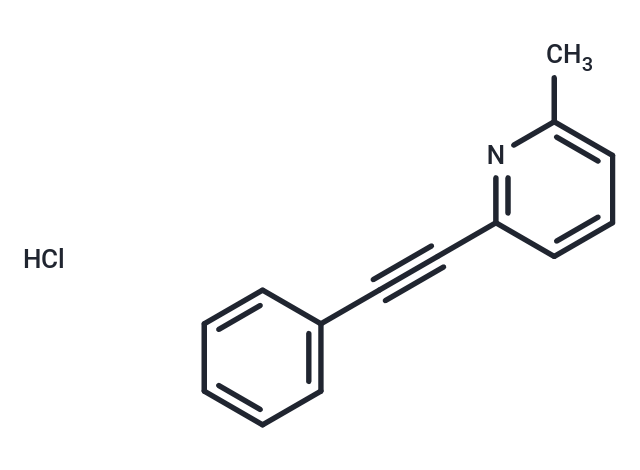Shopping Cart
- Remove All
 Your shopping cart is currently empty
Your shopping cart is currently empty

MPEP is a selective mGlu5 receptor antagonist with IC50 of 36 nM, exhibits no appreciable activity at mGlu1b/2/3/4a/7b/8a/6 receptors.

| Pack Size | Price | Availability | Quantity |
|---|---|---|---|
| 10 mg | $40 | In Stock | |
| 25 mg | $77 | In Stock | |
| 50 mg | $139 | In Stock | |
| 100 mg | $222 | In Stock | |
| 200 mg | $328 | In Stock | |
| 500 mg | $552 | In Stock |
| Description | MPEP is a selective mGlu5 receptor antagonist with IC50 of 36 nM, exhibits no appreciable activity at mGlu1b/2/3/4a/7b/8a/6 receptors. |
| Targets&IC50 | mGluR5:36 nM |
| In vitro | MPEP has no appreciable agonist or antagonist activity at the closely related recombinant human mGlu1b receptor expressed in CHO-K1 cells or a purinoreceptor endogenously expressed in L(tk-) cells up to concentrations of 100 μM. Furthermore, MPEP shows no appreciable agonist or antagonist activity in cAMP accumulation or [35S]-GTPγS binding assays at the recombinant human group II and III metabotropic receptors (human mGlu2, -3, -4a, -6, -7b, -8a) as well as the human NMDA (NMDAR1A/2A, -1A/2B), rat AMPA (GluR3) and human kainate (GluR6) receptor subtypes. In slices of rat neonatal hippocampus, striatum, and cortex but not cerebellum, MPEP inhibits DHPG-stimulated PI hydrolysis with IC50 of 8.0 nM, 20.5 nM, and 17.9 nM, respectively. [1] MPEP positively modulates the hmGluR4 in a recombinant expression system, and the effect of MPEP is fully dependent on the activation of the orthosteric agonist L-AP4. [3] |
| In vivo | When microiontophoretically applied into the brain of rats, MPEP reduces DHPG-induced excitations but not the excitations induced by AMPA. Following intravenous administration, MPEP produces a dose-dependent inhibition of DHPG-induced but not AMPA-induced excitations with a rapid onset of action. Oral administration of MPEP also exhibits excellent anti-hyperalgesic activity in the Complete Freund's Adjuvant and turpentine models of inflammatory pain. [1] MPEP (1-30 mg/kg) induces anxiolytic-like effects in the conflict drinking test and the elevated plus-maze test in rats as well as in the four-plate test in mice. MPEP (1-20 mg/kg) shortens the immobility time in a tail suspension test in mice, but it is inactive in the behavioural despair test in rats. MPEP has no effect on locomotor activity or motor coordination. [2] MPEP significantly reduces fmr1 but not wild-type center square entries and duration. In open field tests, MPEP reduces fmr1tm1Cgr center field behavior to one indistinguishable from wild-type. MPEP produces a significant reduction of total locomotor activity in three of four groups tested, at both 10 mg/kg and 30 mg/kg. [4] |
| Molecular Weight | 193.24 |
| Formula | C14H11N |
| Cas No. | 96206-92-7 |
| Smiles | Cl.Cc1cccc(n1)C#Cc1ccccc1 |
| Relative Density. | 1.10 g/cm3 (Predicted) |
| Storage | Powder: -20°C for 3 years | In solvent: -80°C for 1 year | Shipping with blue ice. | |||||||||||||||||||||||||||||||||||
| Solubility Information | H2O: < 1 mg/mL (insoluble or slightly soluble) DMSO: 37 mg/mL (191.5 mM) Ethanol: 37 mg/mL (191.5 mM) | |||||||||||||||||||||||||||||||||||
Solution Preparation Table | ||||||||||||||||||||||||||||||||||||
DMSO/Ethanol
| ||||||||||||||||||||||||||||||||||||

Copyright © 2015-2024 TargetMol Chemicals Inc. All Rights Reserved.